Highly popular houseplants, Christmas cactuses feature fantastic flowers that typically brighten our homes – but they can thrive in outdoor gardens too, provided your winters are mild enough.
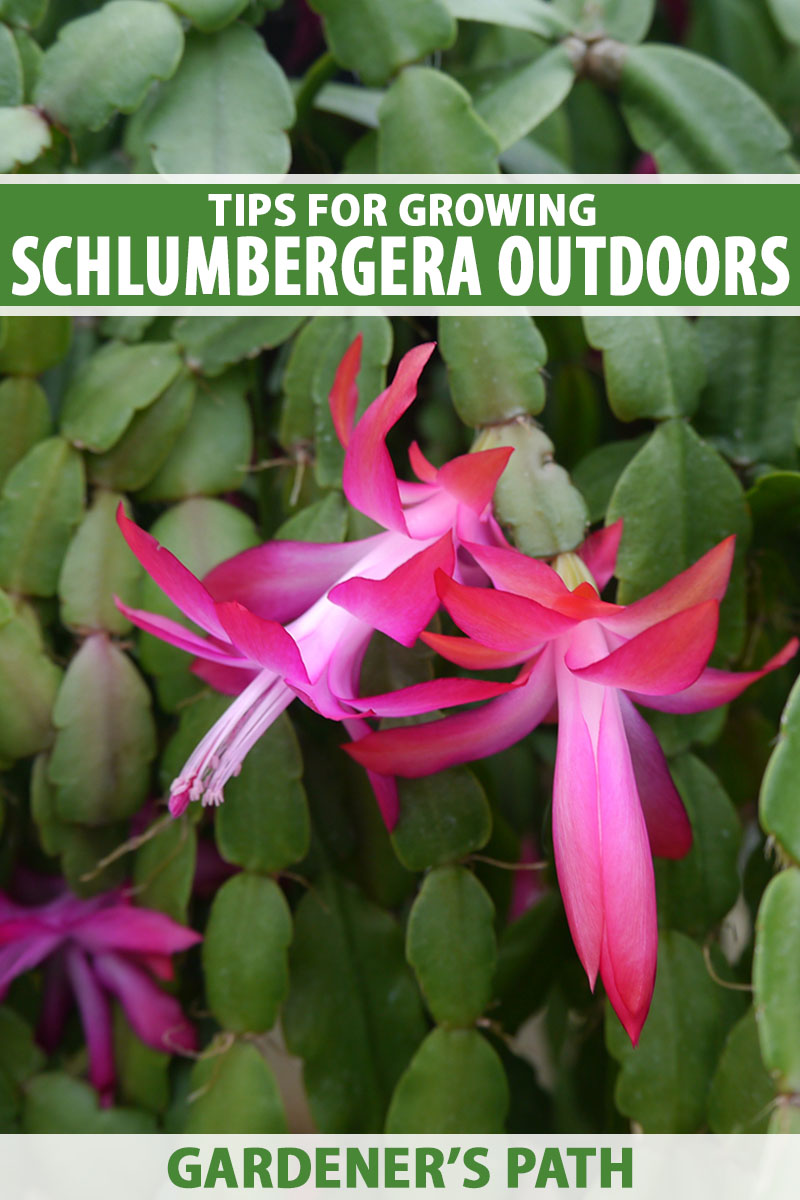
We link to vendors to help you find relevant products. If you buy from one of our links, we may earn a commission.
Native to moist and shady tropical and subtropical forests, these frost-tender perennials of the Schlumbergera genus thrive in partial sun or shady gardens with moderate summer temperatures and mild winters.
However, as the plants are hardy only in USDA Zones 10 to 12, year-round outdoor cultivation is limited to frost-free regions.
But even if you live in a temperate area, these plants love spending summers outdoors and respond with an easy and reliable bud set as fall arrives.
These colorful cacti are photoperiodical, or short-day plants, and flowering is triggered by the longer hours of darkness and cooler temperatures of the changing seasons.
And this makes the timing perfect to enjoy their elegant, vividly colored flowers in cream, gold, orange, pink, red, scarlet, or white in the late autumn and early winter garden – or indoors for the holiday season!
Does your garden (or home) need some luscious, tropical blooms this winter? Then join us now for a detailed explanation of the easy steps required to grow Christmas cactus outdoors!
What You’ll Learn
Outdoor Schlumbergera Cultivation
Plants sold as Christmas or Thanksgiving cactus are species and cultivars of the Schlumbergera genus, specifically S. x buckleyi and S. truncata, and outdoor cultivation for both types of holiday cacti is the same.

Easter cactus, S. gaertneri, is also grown in the same manner but you won’t see the flower buds until the following spring.
They enjoy a growing season with moderate temperatures in the range of 70 to 80°F and a location with light shade or morning sun. But avoid hot afternoon sun which can scorch the leaves.
Holiday cacti flower in response to longer nights and cooler temperatures, forming buds when nighttime temperatures drop to 55°F – watch for buds starting to form at the stem tips as summer winds down and fall approaches.
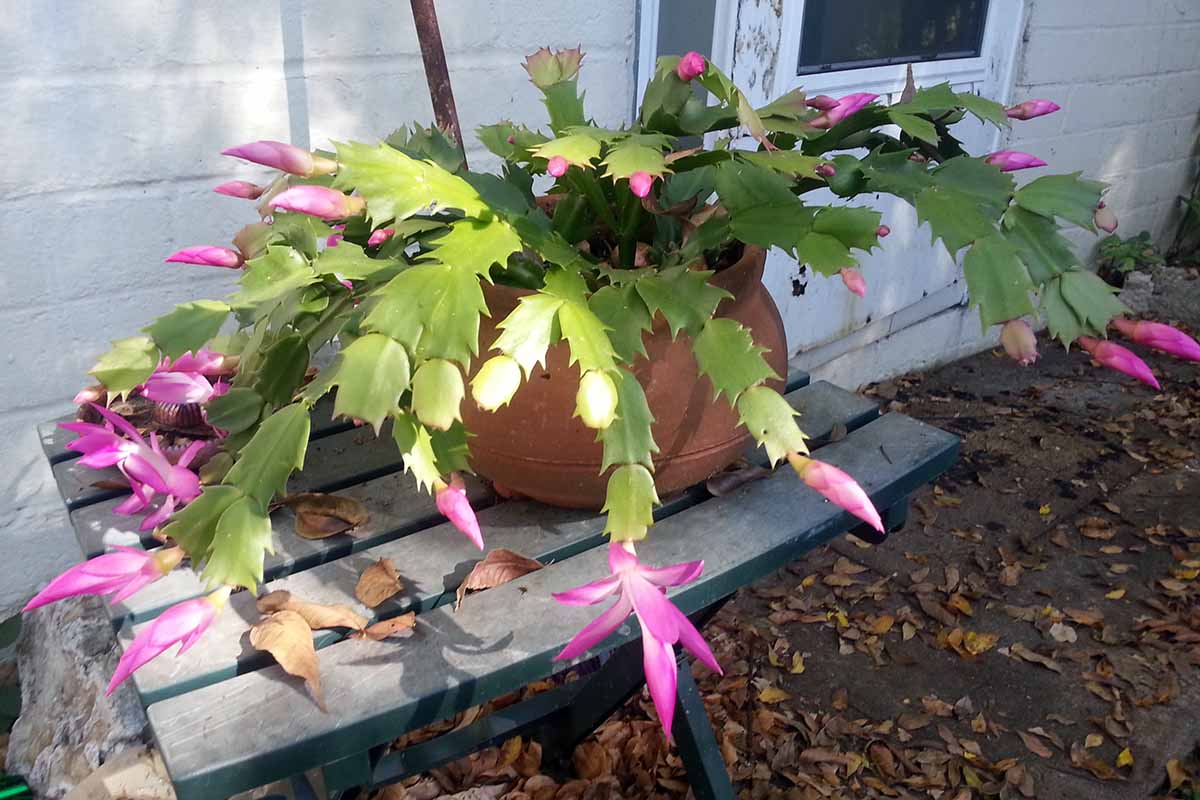
These low-maintenance plants prefer humus-rich soil with a sharp or gritty texture and a slightly acidic pH of 5.5 to 6.2.
Use loamy or sandy soil and amend with landscape sand, granite chips, or pumice by up to a third of the mix to ensure excellent drainage.
Mix a little bone meal into the planting site to encourage strong roots.
Dig a hole the same size as the existing pot, then gently remove the plant, taking care not to disturb the roots. Set the plant at the same depth as it was in the container.
Space them two to three feet away from other plantings to allow for mature dimensions.
Water plants regularly when the top inch of soil is dry, but don’t allow the soil to become bone dry. It’s best to water at the soil line and avoid sprinkling the foliage. And don’t overwater because wet soil is the leading cause of root rot.
Pruning and Maintenance
Holiday cacti should be pruned right after flowering, and no later than four weeks after flowers have finished.
Plants enter a growth period after flowering and pruning at any other time can detrimentally impact flowering.
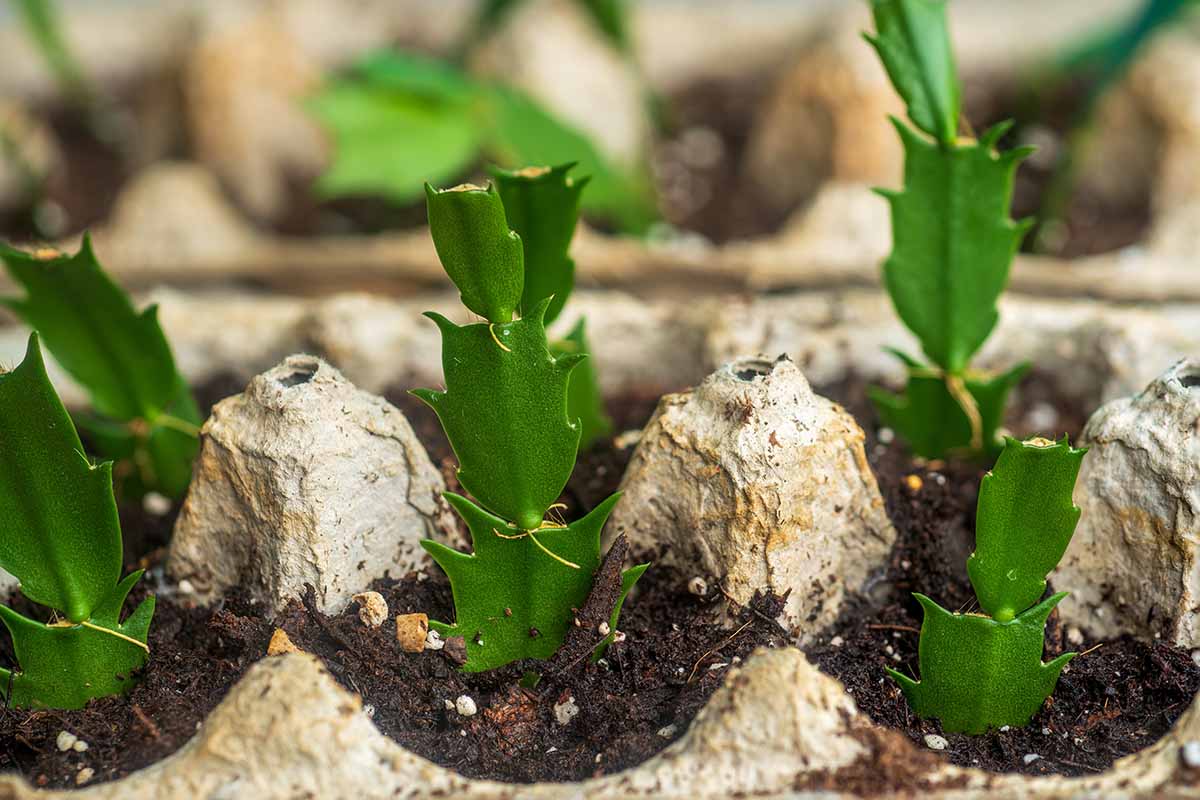
To prune, use a clean, sharp knife or garden shears to cut between the leaf segments, removing one to three segments to shape plants and force branching, which promotes bushiness and more flowers.
To reduce the size of large plants, remove up to one-third of the overall growth.
And you can use the trimmings to easily root cuttings for new plants – read up on the easy Christmas cactus propagation steps in our guide.
If desired, add a two- to four-inch layer of bark mulch over the root zone for winter insulation.
Remove the winter mulch in early spring and side dress with aged compost, gently working it in around the roots.
During the growing season, from April to October, feed plants monthly with a balanced liquid fertilizer with a nutrient ratio such as 10-10-10 NPK.
Withhold feeding from mid-autumn through winter, or from October to March.
Unless your winters are very dry, reduce watering in winter, allowing the top two inches of soil to dry out between water applications.
Should the threat of frost arise in warm zones suitable for outdoor cultivation, or when temperatures dip to 40°F, cover plants with a cloche or landscape fabric for protection.
Remove covers once all danger of frost has passed after temperatures increase.
Container Care
For container growth, be sure to choose pots with a drainage hole. I like to add a one- to two-inch layer of drainage material to the bottom.
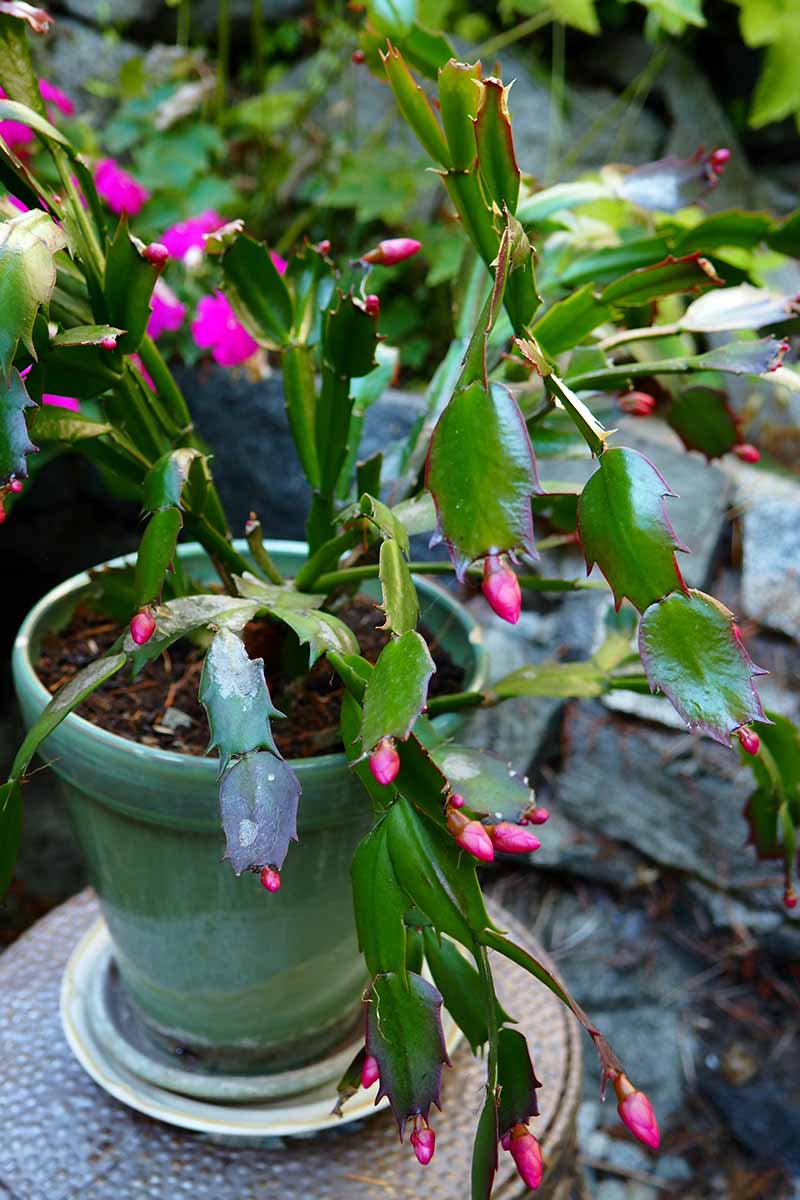
Fill pots to two inches from the rim with a rough-textured, humus-rich potting blend. If needed, amend the soil with granite chips, landscape sand, or pumice to ensure well-draining soil.
Place containers in a spot outdoors with morning sun or dappled sunlight during the growing season.
Containers can be moved into a sunnier spot during fall and winter, provided the sunlight isn’t strong enough to burn the leaves.
Water plants when the top inch of soil is dry to the touch.
Feed container plants every two weeks during the growing season with a half-strength solution of a balanced liquid fertilizer such as 10-10-10 NPK.
Moving Inside Pots Out
For gardeners in temperate regions, moving your houseplants outdoors for the growing season is an easy way to ensure a full bud set for abundant flowers.
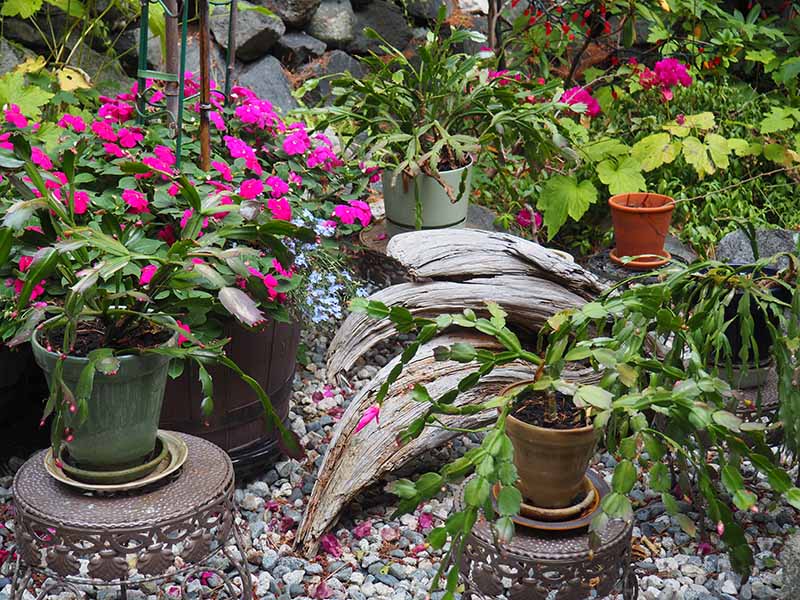
When temperatures are reliably above 50°F, move plants to a location with morning sun or light shade but avoid exposure to strong, hot sunshine.
Do this gradually, to allow them to acclimate to outdoor conditions – start with one hour on the first day and gradually increase the amount of time they spend outdoors over the course of a week to 10 days.
Keep the soil on the dry side, but not dusty dry – water when the top inch of soil is dry to the touch. Fertilize as outlined in the section on container care above.
When fall arrives, or when overnight temperatures drop to 50°F, move plants back indoors.
Check that no insects are coming inside with the plants – a gentle spray or stream of water will remove most pests but take care not to knock off any flower buds.
Allow plants to dry before moving them to their winter location. Avoid areas with cool drafts or warm air blowing from heat vents, which can cause buds to drop.
Learn more about how to grow Christmas cactus indoors in our guide.
Managing Pests and Disease
Schlumbergera cultivars are generally problem-free but can suffer damage from a few pests.
When grown outdoors, watch for mealybugs, small sapsuckers that appear as fluffy bits of white cotton. Use a cotton swab dipped in rubbing alcohol to rid plants of mealybugs.
Other pests can include aphids, mites, and scale, which can be controlled with a spray of insecticidal soap or neem oil.
Diseases are few and far between and mostly caused by overwatering, which can promote issues such as bacterial soft rot, damping off, and fusarium wilt.
To avoid these problems, ensure plants have a well-draining location and water only when the top inch of soil is dry.
For more tips on keeping your plants healthy, check out our article on how to identify and control seven common Christmas cactus pests.
Quick Reference Growing Guide
| Plant Type: | Flowering epiphyte | Flower / Foliage Color: | Red, pink, purple, white, yellow, orange, salmon |
| Native to: | Brazil | Water Needs: | Low to moderate |
| Hardiness (USDA Zone): | 10-12 | Maintenance: | Low |
| Bloom Time / Season: | Late fall to early winter | Tolerance: | Drought, shade |
| Exposure: | Light shade, morning sun | Soil Type: | Loamy, humus-rich |
| Time to Maturity: | 2-3 years | Soil pH: | 5.5-6.2 |
| Spacing: | 2-3 feet | Soil Drainage: | Well-draining |
| Planting Depth: | 1/2-1 inch | Attracts: | Hummingbirds |
| Height: | 1 foot | Family: | Cactaceae |
| Spread: | 2 feet | Genus: | Schlumbergera |
| Common Pests and Diseases: | Aphids, mealybugs, mites, scale; Bacterial soft rot, damping off, fusarium wilt | Species: | x buckleyi, gaertneri, truncata |
Blooming Beautiful
In the right conditions, Christmas cactuses can provide gardeners with bright, colorful flowers over the winter holidays, both indoors and outside.
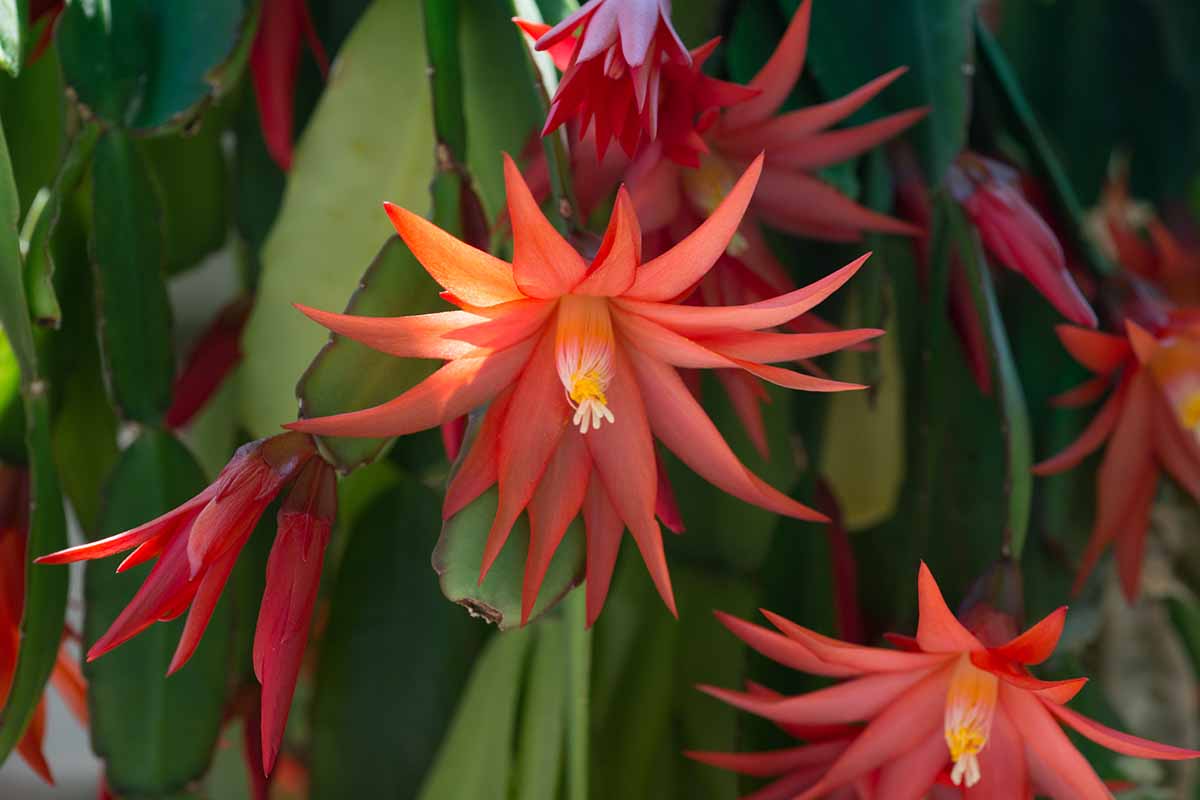
But to grow them as garden perennials, they require mild winter temperatures along with well-draining soil and the right lighting.
If your winters are too cold for in-ground outdoor growth, move your houseplants outside for summer and bring them in after autumn arrives to enjoy those blooming beautiful flowers indoors!
Do any of you folks grow Schlumbergera outside? Share your growing tips in the comments section below.
And for more Christmas cactus know-how, add these guides to your reading list next: